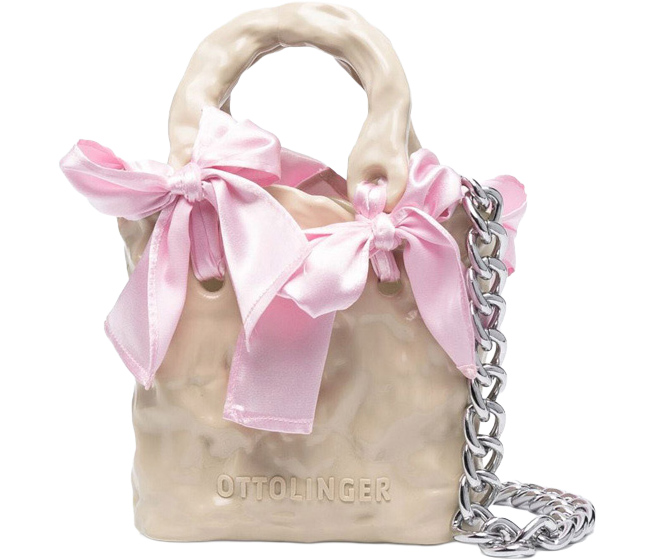Aliens, chemtrails & other tails….
Cosima Gadient: Yeah… I think of old books.
Nayeun Kim: Like trilogies, conquests… a journey of a central character…
Christa Bösch & Cosima Gadient: Yes! Like Narnia and those kinds of books.
NK: So, thinking of Ottolinger as a saga, how does it begin?
CG: It did start in Switzerland [they glance at each other]. That’s where we met and then we decided to make a move, to go to Berlin and start the brand. But we met in Switzerland, so I guess we could say it started there.
NK: Has there been a specific moment that’s been most memorable for you?
CG: There’s been a few. Sometimes, I only realise something was memorable when I look back. Like the VFiles competition because that opened up a lot of doors for us.
CB: Hey, VFiles was quite big back then!
NK: Wait, I didn’t know you were in VFiles?!
CB: Yeah, and in a way, you could say that’s how we actually started.
CG: We weren’t fully aware of how important it would be for us, but it was. It was really after that experience that we met more people and started changing our practice. We got into a rhythm of consistently doing stuff – it just started rolling, you know?
CB: It’s true. I remember you being sick and I was on the call with Ruth [Gruca] and she said, “This is going to totally change your life!” and I was like, “uh huh…” and it actually did.
CG: Maybe not change forever…
CB: Yeah, not forever, but in a way!
CG: She did say that – super American – and at the time, we were like, “oh, come on.”
CB: And it did change something. Especially for us and our brand.
CG: After that, when everything was rolling, it felt like we were running, trying to catch this and catch that. Sometimes things only start to move once someone else enters the picture.
NK: Then do you believe in fate or destiny?
CB: That’s tough. I mean, sure, but you still have to be active. It’s not like you can just say “ah, my destiny is coming.”
CG: I think it’s both. To say no doesn’t seem right but you still need to work hard.
CB: I guess you just never know and that’s what makes it a hard question.
CG: It’s always easier to say something was meant to be in hindsight. Like when something doesn’t work out, we say there was a reason it didn’t work out. That’s the thing – when you say you believe in destiny or whatever, it could be toxic because you take away the chance of something being unexpectedly good.
NK: So I guess you’re not superstitious?
CB: My parents got married on Friday 13th and they’re still together…
NK: Did you know that in Asia there are buildings without a fourth floor because the number four is considered the devil’s number?
CB: I guess that’s like how some aircrafts would skip row 13. I personally see a lot of signs.
We all look out the window and for once in Berlin, it’s sunny – we take this as a “sign” and laugh.
CG: I love that, it’s comforting! Especially in the work that we do because there isn’t a lot of security mentally because we’re on our own. These things [like seeing signs] make it easier to accept things. Like “ah, this was meant to be.” Or it just feels good and we don’t know any better.
NK: I like to think that you’re given different life paths and if you put yourself out there, you can have access to these paths. But It won’t come to find you.
CG: But maybe that’s just your destiny! [Laughs]
NK: Oh my god! I can see how this could quickly become a spiral. I’m going to go back to the early days of Ottolinger instead, to the brand’s distinctive “trial and error” approach…
CB & CG: Huh?
CB: A what era?
NK: No, trial and error.
CB: Ah, trial and error! I thought you said “trail era.”
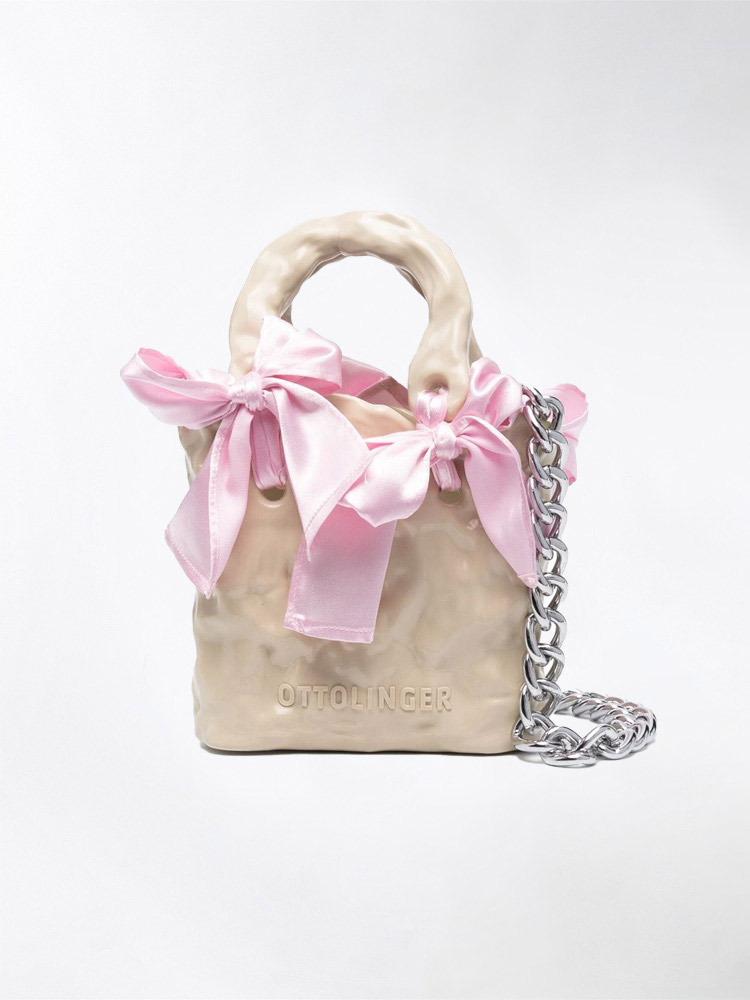
NK: Trial and error! Let’s talk about your early approach to textiles; ripping, restitching and blowtorching the garments. If we call that period the blowtorch era, can you tell us about the era we’re in now?
CG: [Laughs] I think we’ve been trying to bring the blowtorch back many times. But since we’ve grown, it’s hard to maintain it as a sustainable practice for production.
CB: I’d say we had a strappy era also.
NK: Oh, the strappy era was big.
CB: We also had an acid era…
NK: What other eras have you had?
CB: I feel like we’re now ready for a lady era. More like, “grown up”, as we have.
NK: Sophisticated!
CB: In a way – let’s see!
NK: I can see your mind working right now. [Looking over at Cosima]
CG: Yeah… I’m just thinking about what Christa and I have been discussing lately. Just about the stuff we’re putting out there and even about how to justify making garments in the current global state. In the end, we want to bring a fresh perspective on the modern woman or our so-called lady era.
CB: Maybe “lady” isn’t the best word…
CG: No, not being lady-like but having elegance with a rough edge that is effortless — to us, that’s beautiful and extremely powerful. I think of that phrase, “what question are you throwing in the room?”
CB: It’s the same as liking a person. You think you look for something perfect but you’re more likely to be attracted to someone with an edge, rather than perfection.
CG: Is it the “throwing the question” era? [Laughs]
NK: Well, speaking of throwing questions, we’re also exploring fantasy, fairy tales and conspiracies in this issue. Are you personally a fan of any of these genres?
CB: I like science fiction and fantasy books that are written today and not from a hundred years ago.
NK: Are we talking about, like, Game of Thrones type?
CG: Well, I love old fairy tales… like Lord of the Rings…
NK: Did you ever enjoy Greek mythology?
CG: Yeah, I love that! The themes are still contemporary. It reflects on who we are; the root of how humans think.Written in a way that seems far from us, but really, it’s just about us.
NK: Switzerland is also the birthplace of a lot of fairy tales. Did you have a favourite growing up?
CB: I always liked Brüder Grimm, but that’s German.
CG: Probably Heidi.
NK: Yes, I love Heidi!
CG: Yeah, she’s so strong and it’s actually extremely sad. I even remember crying when I first read the story.
CB: What about Schellen-Ursli? That’s another good story.
NK: What’s it about?
CB: It’s about a boy from a village and they have a spring-time tradition of taking bells around the village
NK: Why the bells?
CB: It’s their village tradition and because he wants a bigger bekk than the others, he has to go find it.
CG: His family has a bigger bell but it’s in a family cabin up in the mountains where it’s very snowy. He musters up the courage to go there but ends up getting trapped in the snow, so it’s about kids being alone in nature – a bit like Heidi – and they have to find ways to make it through these tough environments and situations.
CB: His house is still standing in the village, you can go up there and visit.
NK: Hang on, you can visit the house? Isn’t this just a legend?
CB: I mean…
NK: Is it real?
CG: Well, no, it’s a tale. The book has amazing illustrations that aren’t something you’d typically imagine for children, by an artist named Alois Carigiet from the eastern part of Switzerland. He wrote about five or six books for children – the stories can be kind of dark and many adults read them, too – but the village where he grew up and where the stories all take place is still around.
NK: That reminds me a little bit of The Little Prince.
CG: It’s kind of a version of that because the moral of the story doesn’t only apply to children and it speaks about how we perceive and relate to the world around us.
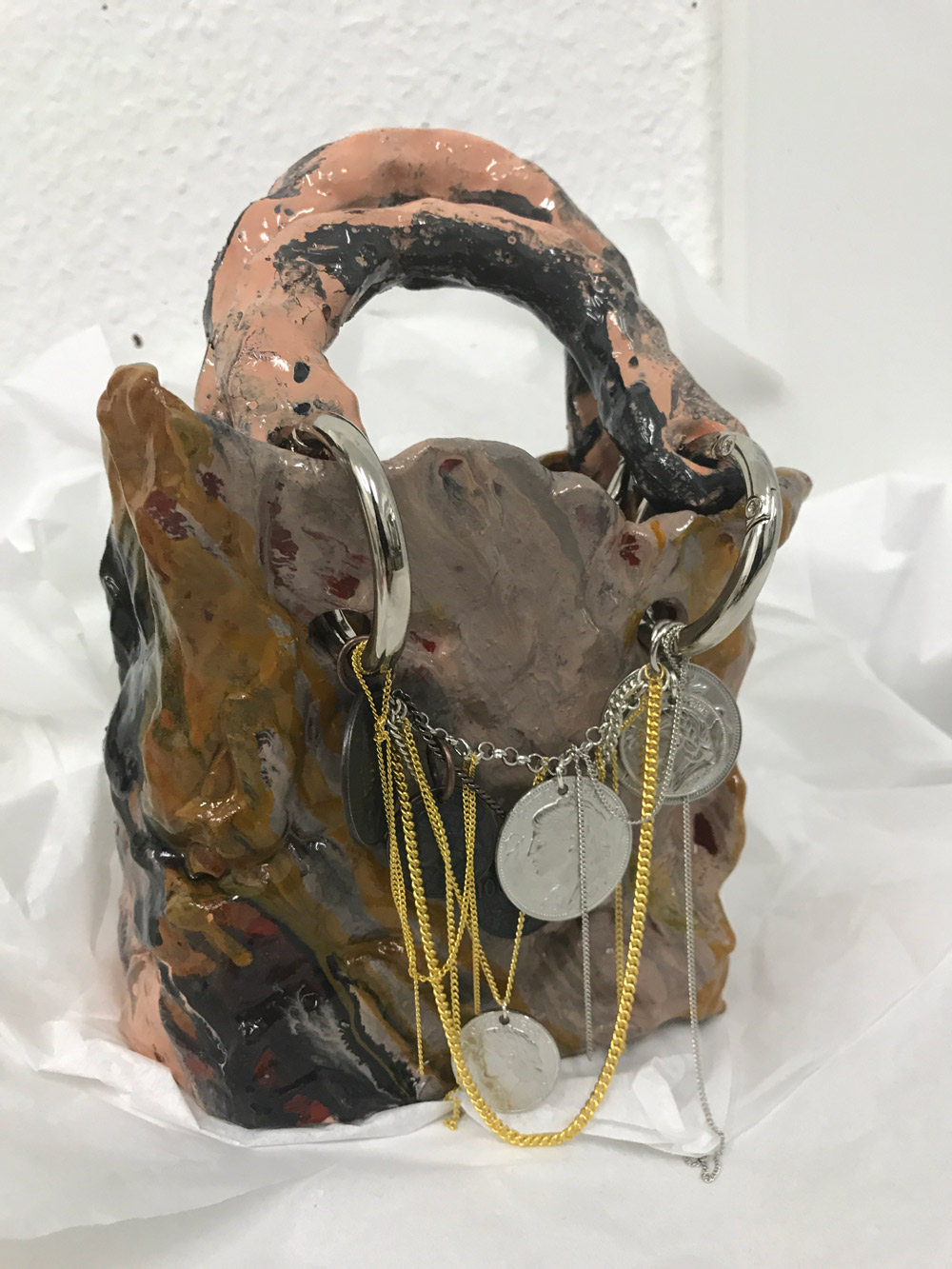
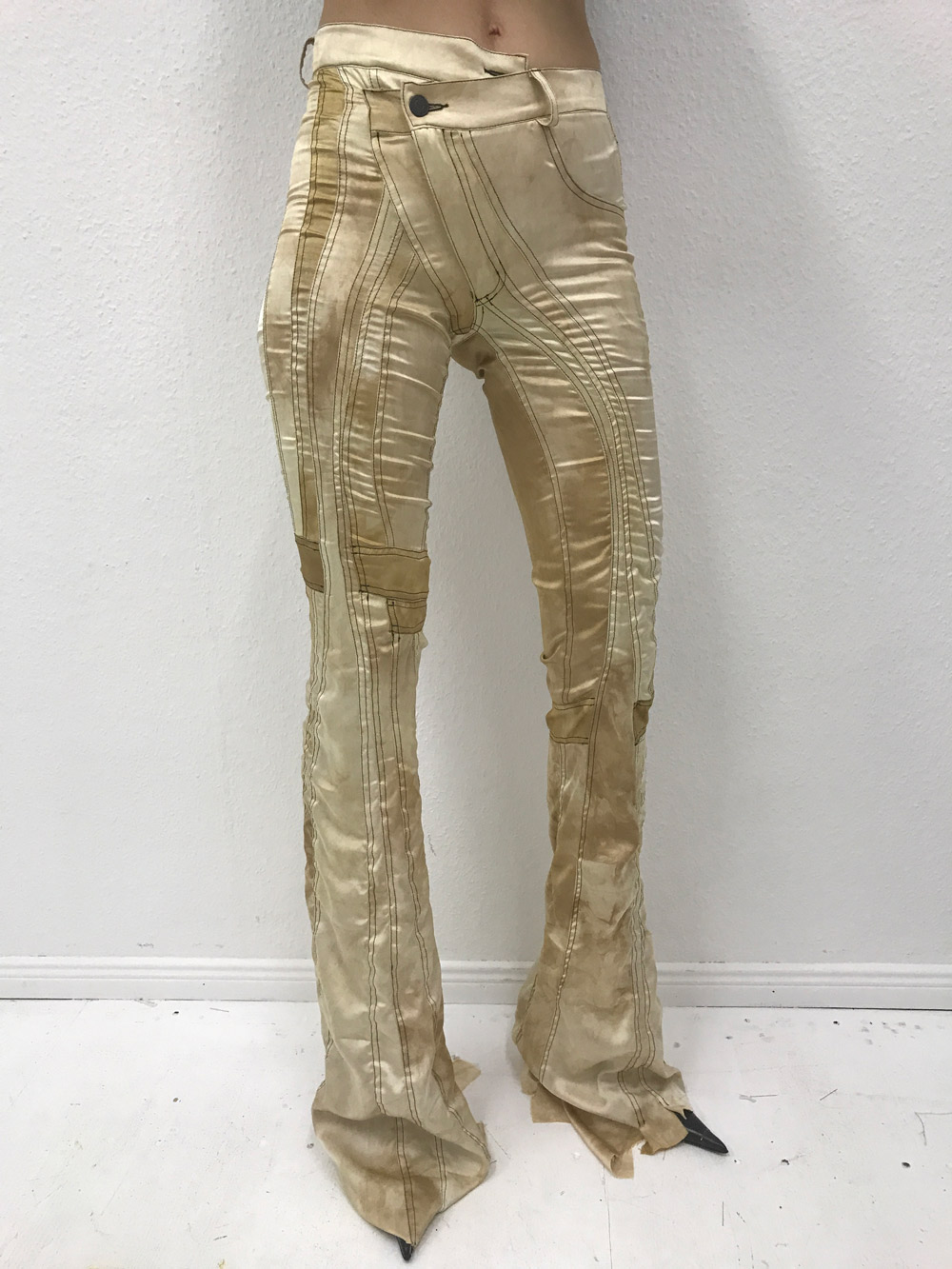
NK: What’s your thought on conspiracy theories?
CB: I’m reading a book by one of my favourite Austrian authors. Hetalks about a guy who believes in a conspiracy theory that humans live inside the earth.
CG: What? Then what would we look up towards?
CB: We’d be looking up at the inside, so for example, if we’re here and look up, we could be looking up at Australia.
NK: This is such a mindfuck!
CB: It follows the character who is a veteran of the World Warand he didn’t believe this theory before but he does now… I don’t have all the details yet because I’m still reading the book. By the way, it’s not my favourite conspiracy, it’s just what I’ve been reading now.
My parents got married on Friday 13th and they’re still together…
NK: Well, have you heard about the one about Beyoncé being a lizard alien?
CB: What do you mean she’s a lizard?
CG: She’s supposedly a reptile.
NK: You never heard about this?
CB: Do people really believe that?
CG & NK: Yeah!
CB: Right, obviously! [Laughs]
CG: They’re not conspiracies but I do love the Egyptian hieroglyphics and the stories around them, trying to decipher what these animal or “alien” heads are supposed to represent.
CB: It’s always very interesting to read about these things because the thing is, if you really think it could be true, then it could easily become twisted… and who really knows?
CG: It doesn’t change anything though, does it?
CB: I mean, no, I would still need water to drink, but it changes the perception.
CG: Oh, I just remembered something! The cornfields!
NK: Which one is that?
CG: Remember from the 90s?
NK: Oh, yes, the alien signs!
CG: Yeah, and actually, they’re really beautiful.
NK: They’re supposed to be real right? There’s photographs of these fields.
CG: You know, on a random Sunday afternoon, one little funny search and you can end up in a very funny corner of YouTube like, “oh, yep, alien abduction.”
NK: And two, three hours later you’re like, “oh my god, what did I just watch?”
CG: There are things you can’t explain, which I love. Part of having something that can’t be explained is extremely beautiful. We can’t have the answer to everything.
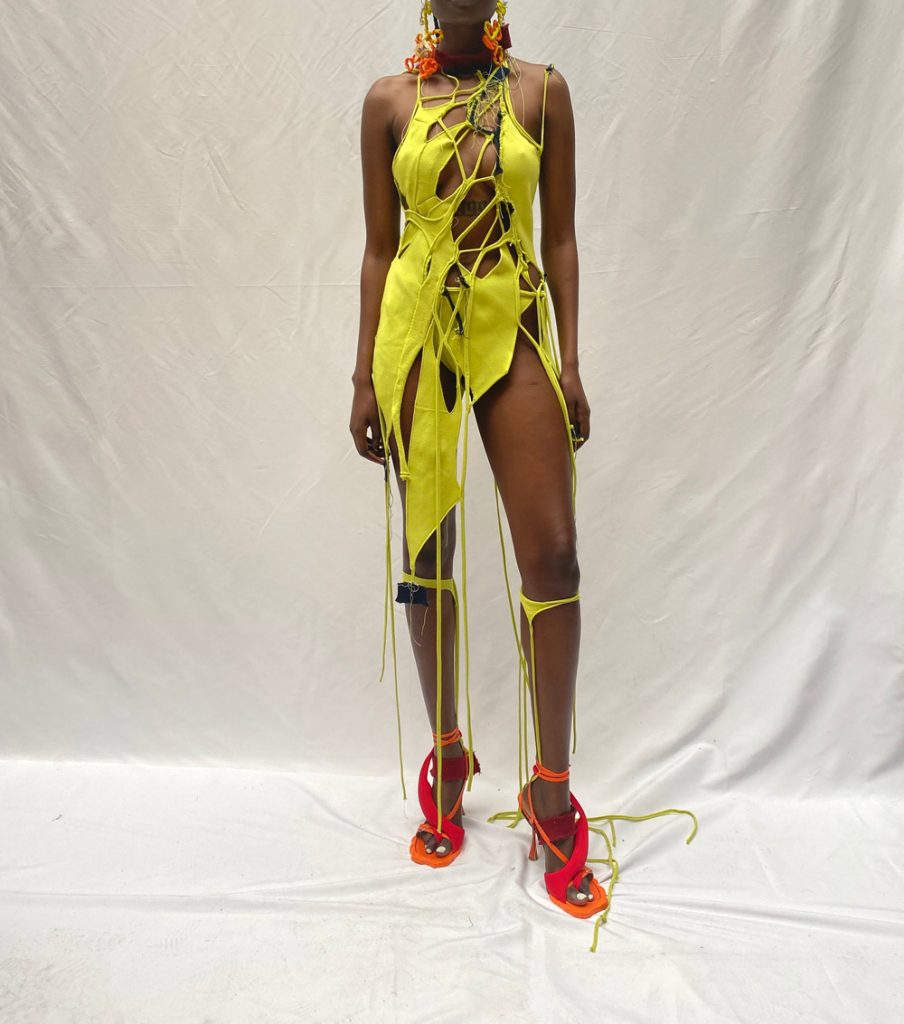
NK: It’s a weird one to think about because conspiracies are in the end a lot of speculation but they show how powerful human perception and imagination can be. While we’re on this topic, are there any misconceptions about Ottolinger you want to debunk?
CB: Hm.. I don’t know…
NK: What’s funny to me is that everyone thinks Ottolinger is based in the US.
CB: Yes, that’s true!
CG: And that it’s a guy!
NK: Not everyone seems to realise it’s run by two women.
CG: If that’s true, like, where would he even be based in the States? Is he in LA? A surfer boy? [Laughs]
NK: He could totally be an LA, Hollywood type. [Laughs]
CB: Maybe people assume it’s a guy because of the name. But location-wise, I always thought it was pretty clear we were in Berlin!
NK: We’ve spoken about misconceptions, conspiracies and the stories we grew up with. What about the truth? Where do you find your truths in this world and for your designs?
CB: In nature or inside yourself. Of course, you go outside, see what’s going on in the street, see what’s on the Internet and all that. But at the end truth comes when you’re honest with yourself, focusing on the craft undisturbed.
CG: It’s a lot of inside work. For that to happen, you need silence. It’s something we need in order to create an authentic character.
NK: So you tap into your inner self. Would you say your designs reflect different parts of yourself?
CB: I guess they are but we’re also evolving so it becomes different versions of us. It’s more of a feeling of a person that we’re trying to create. It’s not like creating a main characterfor the sake of a story.
CG: I think it goes back to the question you asked earlier, “what era are you in?” We’re trying to raise new questions. We’re trying to grow and our audience is growing with us. We’re constantly in discussion. We pull out things and ask, “what’s the meaning of this?” If we want to evolve from this Ottolinger person, “who are they now?” It’s not a superficial question like, “are they pretty?” It’s finding a balance of contradicting things.
NK: Like a good conspiracy theory!
| Interview | Nayeun Kim |
| Images | Archive images by Ottolinger |

